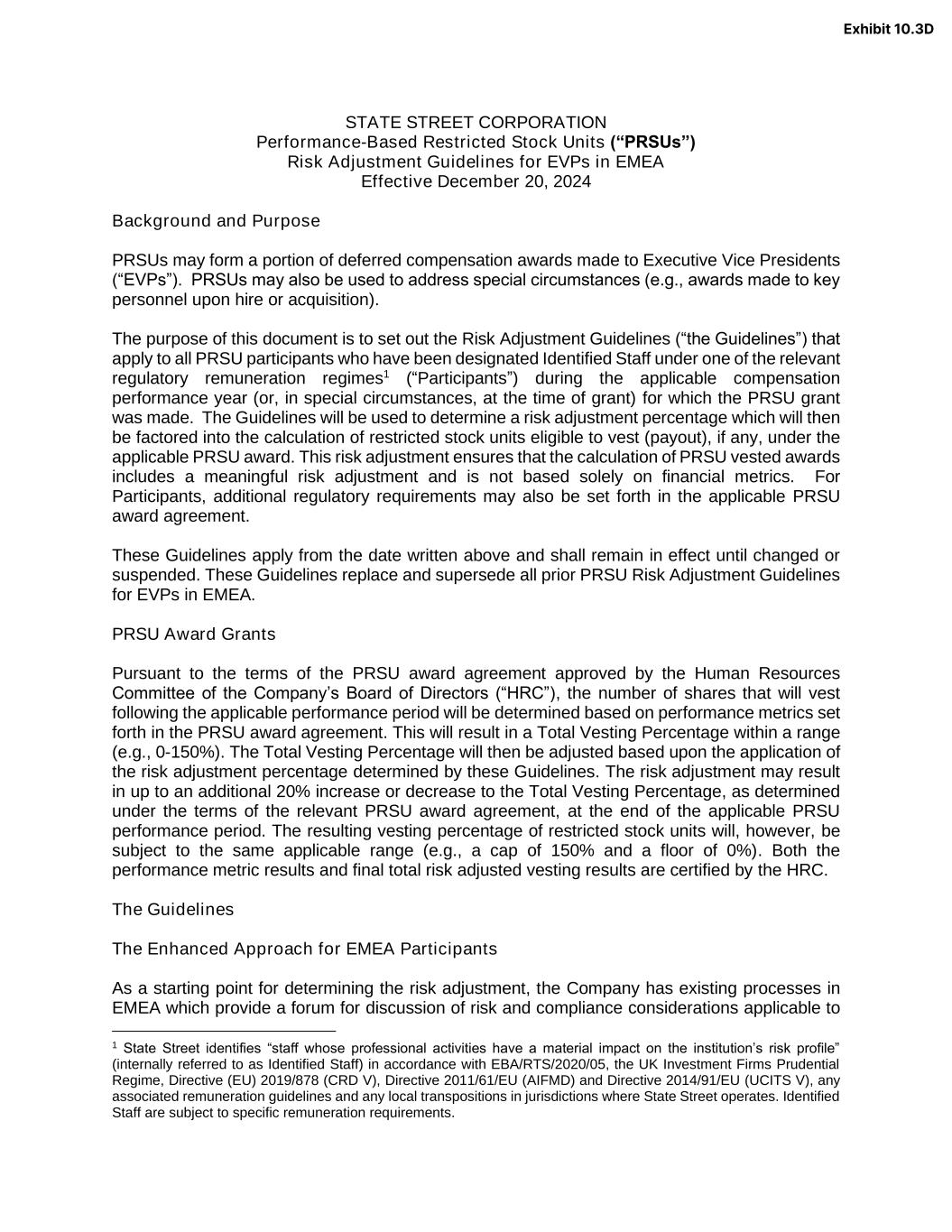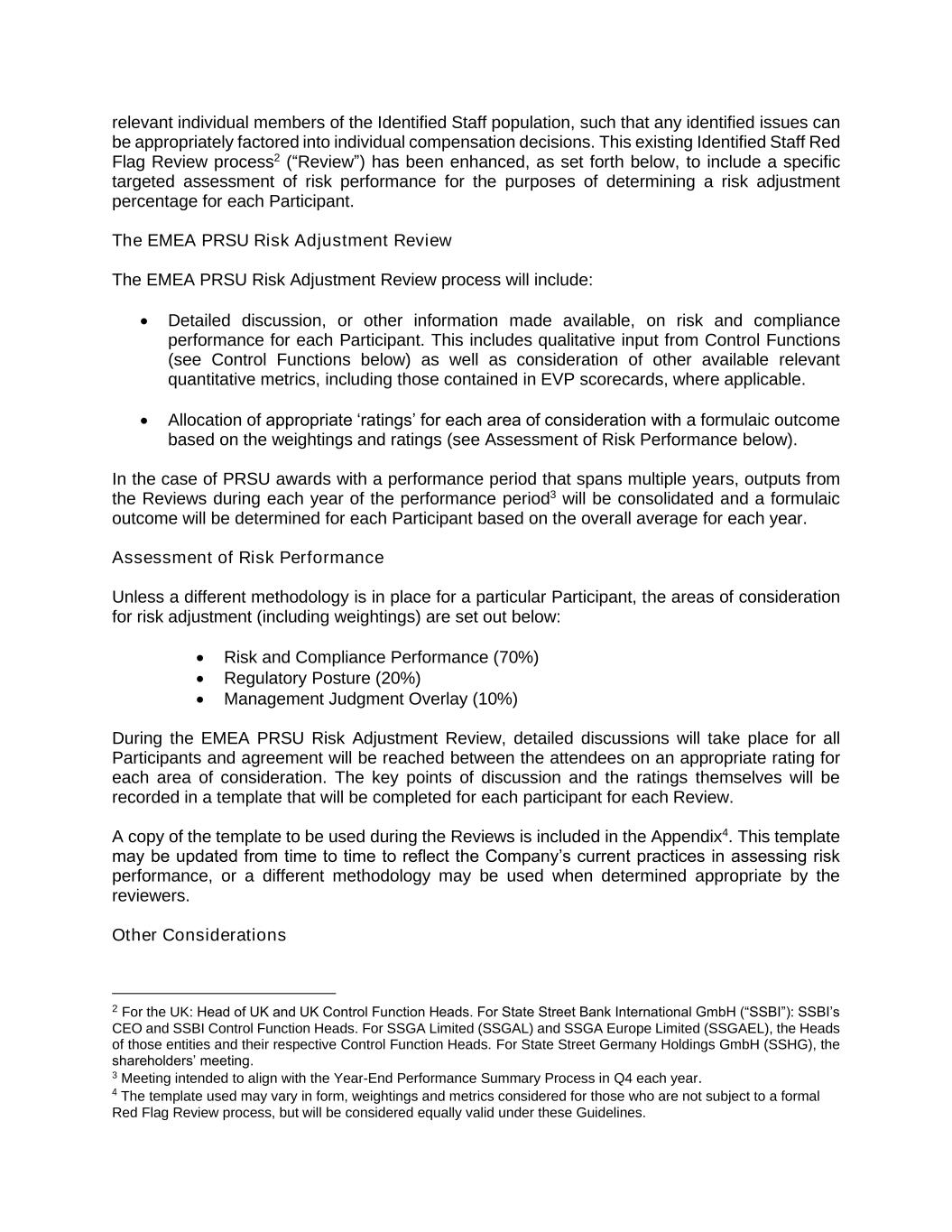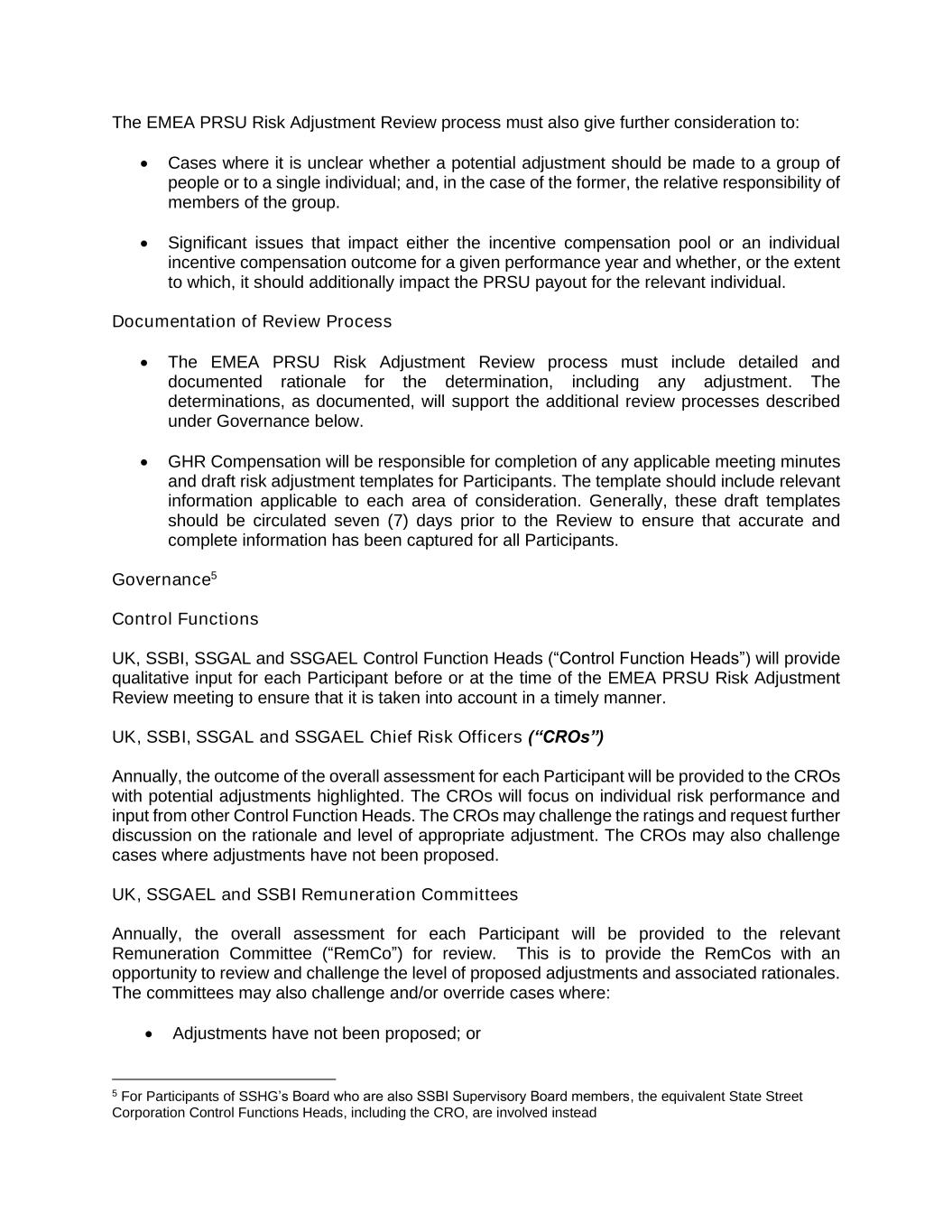
STATE STREET CORPORATION Performance-Based Restricted Stock Units (“PRSUs”) Risk Adjustment Guidelines for EVPs in EMEA Effective December 20, 2024 Background and Purpose PRSUs may form a portion of deferred compensation awards made to Executive Vice Presidents (“EVPs”). PRSUs may also be used to address special circumstances (e.g., awards made to key personnel upon hire or acquisition). The purpose of this document is to set out the Risk Adjustment Guidelines (“the Guidelines”) that apply to all PRSU participants who have been designated Identified Staff under one of the relevant regulatory remuneration regimes1 (“Participants”) during the applicable compensation performance year (or, in special circumstances, at the time of grant) for which the PRSU grant was made. The Guidelines will be used to determine a risk adjustment percentage which will then be factored into the calculation of restricted stock units eligible to vest (payout), if any, under the applicable PRSU award. This risk adjustment ensures that the calculation of PRSU vested awards includes a meaningful risk adjustment and is not based solely on financial metrics. For Participants, additional regulatory requirements may also be set forth in the applicable PRSU award agreement. These Guidelines apply from the date written above and shall remain in effect until changed or suspended. These Guidelines replace and supersede all prior PRSU Risk Adjustment Guidelines for EVPs in EMEA. PRSU Award Grants Pursuant to the terms of the PRSU award agreement approved by the Human Resources Committee of the Company’s Board of Directors (“HRC”), the number of shares that will vest following the applicable performance period will be determined based on performance metrics set forth in the PRSU award agreement. This will result in a Total Vesting Percentage within a range (e.g., 0-150%). The Total Vesting Percentage will then be adjusted based upon the application of the risk adjustment percentage determined by these Guidelines. The risk adjustment may result in up to an additional 20% increase or decrease to the Total Vesting Percentage, as determined under the terms of the relevant PRSU award agreement, at the end of the applicable PRSU performance period. The resulting vesting percentage of restricted stock units will, however, be subject to the same applicable range (e.g., a cap of 150% and a floor of 0%). Both the performance metric results and final total risk adjusted vesting results are certified by the HRC. The Guidelines The Enhanced Approach for EMEA Participants As a starting point for determining the risk adjustment, the Company has existing processes in EMEA which provide a forum for discussion of risk and compliance considerations applicable to 1 State Street identifies “staff whose professional activities have a material impact on the institution’s risk profile” (internally referred to as Identified Staff) in accordance with EBA/RTS/2020/05, the UK Investment Firms Prudential Regime, Directive (EU) 2019/878 (CRD V), Directive 2011/61/EU (AIFMD) and Directive 2014/91/EU (UCITS V), any associated remuneration guidelines and any local transpositions in jurisdictions where State Street operates. Identified Staff are subject to specific remuneration requirements. Exhibit 10.3D

relevant individual members of the Identified Staff population, such that any identified issues can be appropriately factored into individual compensation decisions. This existing Identified Staff Red Flag Review process2 (“Review”) has been enhanced, as set forth below, to include a specific targeted assessment of risk performance for the purposes of determining a risk adjustment percentage for each Participant. The EMEA PRSU Risk Adjustment Review The EMEA PRSU Risk Adjustment Review process will include: • Detailed discussion, or other information made available, on risk and compliance performance for each Participant. This includes qualitative input from Control Functions (see Control Functions below) as well as consideration of other available relevant quantitative metrics, including those contained in EVP scorecards, where applicable. • Allocation of appropriate ‘ratings’ for each area of consideration with a formulaic outcome based on the weightings and ratings (see Assessment of Risk Performance below). In the case of PRSU awards with a performance period that spans multiple years, outputs from the Reviews during each year of the performance period3 will be consolidated and a formulaic outcome will be determined for each Participant based on the overall average for each year. Assessment of Risk Performance Unless a different methodology is in place for a particular Participant, the areas of consideration for risk adjustment (including weightings) are set out below: • Risk and Compliance Performance (70%) • Regulatory Posture (20%) • Management Judgment Overlay (10%) During the EMEA PRSU Risk Adjustment Review, detailed discussions will take place for all Participants and agreement will be reached between the attendees on an appropriate rating for each area of consideration. The key points of discussion and the ratings themselves will be recorded in a template that will be completed for each participant for each Review. A copy of the template to be used during the Reviews is included in the Appendix4. This template may be updated from time to time to reflect the Company’s current practices in assessing risk performance, or a different methodology may be used when determined appropriate by the reviewers. Other Considerations 2 For the UK: Head of UK and UK Control Function Heads. For State Street Bank International GmbH (“SSBI”): SSBI’s CEO and SSBI Control Function Heads. For SSGA Limited (SSGAL) and SSGA Europe Limited (SSGAEL), the Heads of those entities and their respective Control Function Heads. For State Street Germany Holdings GmbH (SSHG), the shareholders’ meeting. 3 Meeting intended to align with the Year-End Performance Summary Process in Q4 each year. 4 The template used may vary in form, weightings and metrics considered for those who are not subject to a formal Red Flag Review process, but will be considered equally valid under these Guidelines.

The EMEA PRSU Risk Adjustment Review process must also give further consideration to: • Cases where it is unclear whether a potential adjustment should be made to a group of people or to a single individual; and, in the case of the former, the relative responsibility of members of the group. • Significant issues that impact either the incentive compensation pool or an individual incentive compensation outcome for a given performance year and whether, or the extent to which, it should additionally impact the PRSU payout for the relevant individual. Documentation of Review Process • The EMEA PRSU Risk Adjustment Review process must include detailed and documented rationale for the determination, including any adjustment. The determinations, as documented, will support the additional review processes described under Governance below. • GHR Compensation will be responsible for completion of any applicable meeting minutes and draft risk adjustment templates for Participants. The template should include relevant information applicable to each area of consideration. Generally, these draft templates should be circulated seven (7) days prior to the Review to ensure that accurate and complete information has been captured for all Participants. Governance5 Control Functions UK, SSBI, SSGAL and SSGAEL Control Function Heads (“Control Function Heads”) will provide qualitative input for each Participant before or at the time of the EMEA PRSU Risk Adjustment Review meeting to ensure that it is taken into account in a timely manner. UK, SSBI, SSGAL and SSGAEL Chief Risk Officers (“CROs”) Annually, the outcome of the overall assessment for each Participant will be provided to the CROs with potential adjustments highlighted. The CROs will focus on individual risk performance and input from other Control Function Heads. The CROs may challenge the ratings and request further discussion on the rationale and level of appropriate adjustment. The CROs may also challenge cases where adjustments have not been proposed. UK, SSGAEL and SSBI Remuneration Committees Annually, the overall assessment for each Participant will be provided to the relevant Remuneration Committee (“RemCo”) for review. This is to provide the RemCos with an opportunity to review and challenge the level of proposed adjustments and associated rationales. The committees may also challenge and/or override cases where: • Adjustments have not been proposed; or 5 For Participants of SSHG’s Board who are also SSBI Supervisory Board members, the equivalent State Street Corporation Control Functions Heads, including the CRO, are involved instead

• The level of adjustments proposed, in the relevant committee’s discretion, is either too little or too great in comparison to the risk event. The RemCo, as applicable, determines the final recommendations to be made to the HRC. Shareholder’s Meeting for Participants of SSHG Annually, the overall assessment for each Participant of SSHG will be provided to the relevant shareholder’s representative for review. This is to provide the shareholder’s representative with an opportunity to review and challenge the level of proposed adjustments and associated rationales. The shareholder’s representative may also challenge and/or override cases where: • Adjustments have not been proposed; or • The level of adjustments proposed, in the relevant committee’s discretion, is either too little or too great in comparison to the risk event. The shareholder’s representative, as applicable, determines the final recommendation to be made to the HRC. The HRC The HRC is ultimately responsible for the final certification of PRSU outcomes before vesting. The outcome of the overall assessment for each Participant will be provided to the HRC. This is to provide the HRC with the final opportunity to review and challenge the level of adjustments and associated rationales. The HRC may also challenge and/or override cases where: • Adjustments have not been proposed; or • The level of adjustments proposed, in the HRC’s discretion, is either too little or too great in comparison to the risk event. In the event the HRC deems it appropriate to adjust the risk adjustment determinations of the respective committees, a representative of the relevant body that conducted the EMEA PRSU Risk Adjustment Review will be available to participate in the HRC meeting at which the final certification of PRSU outcomes is considered. In the event that the HRC has a different view than the relevant body that conducted the EMEA PRSU Risk Adjustment Review on the appropriate level of adjustments, the HRC is ultimately responsible for the final certification of PRSU outcomes and will therefore make the final determination.

Appendix – [Template]




